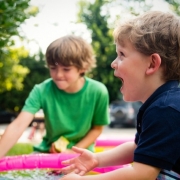The benefits of outdoor play in early years
Whatever the season, there are always amazing activities that children can explore outdoors.
As parents, it’s more important now than ever that we encourage playing outdoors because it is happening less and less. The increase in children’s media usage is well documented, so it’s time to offset the increase in access to technology or as we put it, euphemistically, “screen playtime”.
This 2017 chart shows how screen-based play dominates kids play in the USA and no doubt that pattern will have increased since…

Early years children who watch hours of TV are only using two of their five senses – sight and hearing. This will really limit their ability to process and respond to sensory stimuli as they grow older. Children who play outside are using all their senses by exploring the outdoor spaces – yes, even taste, as they catch snowflakes or raindrops on their tongues.
Whether children are on holiday, or if it’s for an hour after school, anytime is a great time to get children playing in the garden, at a park, on the beach, deep in a forest, climbing a mountain or just in the local square – ALL natural environments will give excellent sensory experiences. It’s also part of learning life lessons with family, friends and enjoying unstructured play with everyone outside the classroom.
A good starting point for outdoor play ideas is emphasising the importance of the natural elements: earth, wind, water and fire (although we will say sunshine, instead of fire!).
How can we approach this? Let’s start with activities like running outside, exploring an area, seeking out birds, insects, mud, sand, grass… even concrete! Catching, hunting, throwing – there is so much out there to do.
Earth: build a mud kitchen to create some delicious mud soup, create a muddy car wash, or mud sculptures, or simply get a little help turning over the soil in your garden.
Wind: go fly a kite, experiment with windmills and streamers, make windsocks to figure out wind directions, catch leaves or relax and watch clouds race through the sky.
Water: jump waves if you are near a coast, visit your local pool or splash park if not, puddle jump or indulge in some garden water play with our Fun2 Play Activity Tray, a multi-purpose tray that can be used for sand and water play, art and craft, lightbox activities or planting.
Fire/Sunshine: investigate shadows, go for a walk, decorate outside spaces, build a shady den, melt some ice, have a picnic, read a book outside or clean the mud kitchen – all play is excellent when the sun is shining, but don’t forget the sunscreen!
An associate of ours, Lucy, suggests making your own new drink flavours in a Kool Aid Sensory Lab, and this is best done in the garden. It’s an activity that works well for all age groups, they will love adding the Kool Aid powder to water in the cylinders, giving it a good stir and observing the colour changes. And it’s drinkable too!
Edx Education’s Whizzy Dizzy gives hours and hours of entertainment for ages 3 and up. Great for encouraging children outside to developing gross motor skills and improving hand-eye coordination, giving healthy exercise and great fun.
Our Circular Sand and Water Tray is designed with multiple interior levels and slopes to allow children to explore many different activities. There is also our rectangular Sand and Water Tray, a multi-purpose activities’ tray which can be used for sand and water play and planting. Both are perfect for messy play – read the full benefits of this in our blog here.
Early years outside play and education should go hand-in-hand. Children will be actively engaged continuously with the excitement of being outside, amongst nature and the elements.
The benefits of outdoor play for development and learning in early years settings has long been recognised and encouraged, with nearly all settings providing early years education will have excellent outside spaces. If they do not because the sessions are in village halls or community centres with little or no access to an outside area, the early years setting should be providing outside play opportunities regardless of their facilities and ensure that outdoor activities are planned and taken on a daily basis.
According to the Learning Outside the Classroom website, there are some powerful arguments to find every opportunity to take young children beyond their immediate indoor environment:
- Learning outside the classroom supports the development of healthy and active lifestyles by offering children opportunities for physical activity, freedom and movement, and promoting a sense of well-being.
- Learning outside the classroom gives children contact with the natural world and offers them experiences that are unique to outdoor activities, such as direct contact with the weather and the seasons.
- Playing and learning outside also helps children to understand and respect nature, the environment and the interdependence of humans, animals, plants, and life cycles.
- Outdoor play also supports children’s problem-solving skills and nurtures their creativity, as well as providing rich opportunities for their developing imagination, inventiveness and resourcefulness.
- Children need an outdoor environment that can provide them with space, both upwards and outwards, and places to explore, experiment, discover, be active and healthy, and develop their physical capabilities.
- The outdoor environment offers space and therefore is particularly important to those children who learn best through active movement. Very young children learn predominately through their sensory and physical experiences which support brain development and the creation of neural networks.
It is important to promote exercise in the face of the increase in childhood obesity, issues with children not building resilience even foundation-level and issues occurring when developing gross motor skills.
Right, outdoor play is extremely important for both physical development and to develop the foundation skills that every child needs – from balance and coordination, creativity and imagination, improved gross motor skills, lower body mass index, the many health benefits, improved muscle strength, increased openness with parents and caregivers, greater self-awareness, appreciation for the environment, improved social skills and peer-to-peer relationships. Plus, children will learn to assess safety and risks, by experimenting on their own.
So, what are you waiting for… Play, learn and create!
Whatever the weather, there is always an interesting game to play if your children use their imagination and creativity. My son loves going out and jumping in the mud once it has rained and we go walking in the fields or even running down the sand dunes.
What techniques have you found to tear kids away from their comfortable media choices inside to explore the great outdoors? And how do you bring the elements of earth, wind, water and fire/sunshine) to life as part of outdoor play? We would love to hear from you.
Edx Education – Heather Welch
To find your local Edx Education retailer head over to Where to buy – Edx Education.



